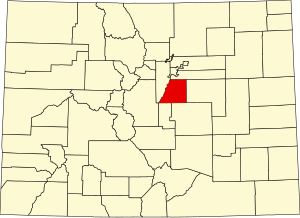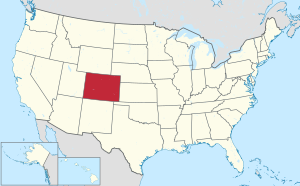Douglas County, Colorado
Douglas County | |
|---|---|
 One of two county buildings for Douglas County in Castle Rock | |
 Location within the U.S. state of Colorado | |
 Colorado's location within the U.S. | |
| Coordinates: 39°21′N 104°56′W / 39.35°N 104.93°W | |
| Country | |
| State | |
| Founded | November 1, 1861 |
| Named for | Stephen A. Douglas |
| Seat | Castle Rock |
| Largest community | Highlands Ranch |
| Area | |
• Total | 843 sq mi (2,180 km2) |
| • Land | 840 sq mi (2,200 km2) |
| • Water | 2.6 sq mi (7 km2) 0.3% |
| Population | |
• Estimate (2015) | 322,387 |
| • Density | 340/sq mi (130/km2) |
| Time zone | UTC−7 (Mountain) |
| • Summer (DST) | UTC−6 (MDT) |
| Congressional districts | 4th, 6th |
| Website | www |



Douglas County is the seventh-most populous of the 64 counties of the U.S. state of Colorado. As of the 2010 census, the population was 285,465.[1] The county seat is Castle Rock.[2]
Douglas County is part of the Denver-Aurora-Lakewood, CO Metropolitan Statistical Area. It is located midway between Colorado's two largest cities, Denver and Colorado Springs. Douglas County has the highest median household income of any Colorado county or statistical equivalent. It is ranked ninth nationally in that category, and has the highest of any county or equivalent not in the eastern US.
Overview
Douglas County is lightly wooded, mostly with ponderosa pine, with broken terrain characterized by mesas, foothills and small streams. Cherry Creek and Plum Creek rise in Douglas County and flow north toward Denver and into the South Platte River. Both were subject to flash flooding in the past, Plum Creek being partially responsible for the Denver flood of 1965. Cherry Creek is now dammed.
Most residents commute to workplaces elsewhere in the metropolitan area outside of the county. Suburban development is displacing the ranching economy of the county.
History
Douglas County was one of the original 17 counties created in the Colorado Territory by the Colorado Territorial Legislature on November 1, 1861. The county was named in honor of U.S. Senator Stephen A. Douglas[3] of Illinois, who died five months before the county was created. The county seat was originally Franktown, but was moved to California Ranch in 1863, and then to Castle Rock in 1874. Although the county's boundaries originally extended eastward to the Kansas state border, in 1874 most of the eastern portion of the county became part of Elbert County.
Geography
According to the U.S. Census Bureau, the county has a total area of 844 square miles (2,190 km2), of which 841 square miles (2,180 km2) is land and 2.6 square miles (6.7 km2) (0.3%) is water.[4]
Adjacent counties
- Jefferson County, Colorado – west
- Arapahoe County, Colorado – north
- Elbert County, Colorado – east
- El Paso County, Colorado – south
- Teller County, Colorado – southwest
Parks and recreational areas
Three state parks fall within Douglas County, Castlewood Canyon State Park, Chatfield State Park and Roxborough State Park. Parts of the county lie within the Pike National Forest and were crossed by the historic South Platte Trail.
Recreation trails in the county include:
- American Discovery Trail
- Colorado Trail
- Devils Head National Recreation Trail
- Highline Canal National Recreation Trail
- Platte River Greenway National Recreation Trail
- Ridgeline Open Space Trail
The Rueter–Hess Reservoir, when filled, may provide significant recreation including fishing, hiking, and non-motorized boating. If filled to capacity, surface size would be 1,140 acres, making this a fairly significant reservoir in Colorado and Douglas County's largest body of water.
Demographics
| Census | Pop. | Note | %± |
|---|---|---|---|
| 1870 | 1,388 | — | |
| 1880 | 2,486 | 79.1% | |
| 1890 | 3,006 | 20.9% | |
| 1900 | 3,120 | 3.8% | |
| 1910 | 3,192 | 2.3% | |
| 1920 | 3,517 | 10.2% | |
| 1930 | 3,498 | −0.5% | |
| 1940 | 3,496 | −0.1% | |
| 1950 | 3,507 | 0.3% | |
| 1960 | 4,816 | 37.3% | |
| 1970 | 8,407 | 74.6% | |
| 1980 | 25,153 | 199.2% | |
| 1990 | 60,391 | 140.1% | |
| 2000 | 175,766 | 191.0% | |
| 2010 | 285,465 | 62.4% | |
| 2015 (est.) | 322,387 | [5] | 12.9% |
| U.S. Decennial Census[6] 1790-1960[7] 1900-1990[8] 1990-2000[9] 2010-2015[1] | |||
As of the census[10] of 2000, there were 175,766 people, 60,924 households, and 49,835 families residing in the county. The population density was 209 people per square mile (81/km²). There were 63,333 housing units at an average density of 75 per square mile (29/km²). The racial makeup of the county was 92.77% White, 2.51% Asian, 0.95% Black, 0.41% Native American, 0.06% Pacific Islander, 1.43% from other races, and 1.88% from two or more races. 5.06% of the population were Hispanic or Latino of any race.
There were 60,924 households out of which 47.2% had children under the age of 18 living with them, 73.8% were married couples living together, 5.7% had a female householder with no husband present, and 18.2% were non-families. 13.3% of all households were made up of individuals and 1.9% had someone living alone who was 65 years of age or older. The average household size was 2.88 and the average family size was 3.19.
In the county the population was spread out with 31.6% under the age of 18, 4.8% from 18 to 24, 37.9% from 25 to 44, 21.6% from 45 to 64, and 4.2% who were 65 years of age or older. The median age was 34 years. For every 100 females there were 99.7 males. For every 100 females age 18 and over, there were 97.4 males.
The median income for a household in the county was $82,929, and the median income for a family was $88,482 (these figures had risen to $93,819 and $102,767 respectively as of a 2007 estimate[11]). Males had a median income of $60,729 versus $38,965 for females. The per capita income for the county was $34,848. About 1.6% of families and 2.1% of the population were below the poverty line, including 1.9% of those under age 18 and 3.7% of those age 65 or over.
Douglas County had the highest median household income of any Colorado county or statistical equivalent in 2000. In 2008, it ranked #8 in the United States in that category – it was one of two in the top 15 not in the vicinity of New York or Washington.
Politics
Like its adjacent county El Paso County, Douglas County has long been known as a Republican stronghold. In the 2012 election Mitt Romney won 62% of the vote, and in the 2016 election Donald Trump won 55% of the vote.[12]
Education
Douglas County is served by Douglas County School District RE-1, the third-largest school district in Colorado. In addition to traditional neighborhood schools, the district includes six charter schools, four option schools and an online school . Schools are rated generally high in the area.
The University Center at Chaparral in Parker offers courses through Arapahoe Community College, University of Colorado Denver, University College of the University of Denver, and the Douglas County School District. The University of Phoenix has a campus in Lone Tree.
The University of Colorado offers courses from both its Boulder campus (the state's flagship university) and its Denver campus at the CU-South Extension in Lone Tree.
Libraries
The Douglas County Libraries system has seven branches throughout the county. The library also houses the Douglas County History Research Center, which collects and preserves the history of Douglas County, the High Plains, the Divide area of the Front Range and the State of Colorado in order to provide historical research resources to the public.[13]
Economy
Top employers

According to the County's 2010 Comprehensive Annual Financial Report,[14] the top employers in the county are:
| # | Employer | # of Employees |
|---|---|---|
| 1 | Douglas County School District RE-1 | 6,245 |
| 2 | EchoStar | 1,840 |
| 3 | CH2M HILL | 1,600 |
| 4 | tw telecom | 1,100 |
| 5 | Western Union | 1,090 |
| 6 | Douglas County | 1,061 |
| 7 | HealthONE: Sky Ridge Medical Center | 1,030 |
| 8 | Centura Health: Parker Adventist Hospitals | 840 |
| 9 | Liberty Media | 730 |
| 10 | IHS | 700 |
Recognition
Douglas County has been recognized by a number of national periodicals:
- Money magazine ranked Douglas County No. 5 in the United States for “Job Growth over the Last Eight Years”. (Towns include Castle Rock, Parker, Stonegate, Lone Tree, and Highlands Ranch), 18 August 2009 [15]
- American City Business Journals (ACBJ) ranked Douglas County No. 4 in the nation for “Quality of Life,” May 2004 [16]
- SchoolDigger.com ranked Douglas County School District at No.1 in the Denver Metropolitan Area and No.12 in Colorado based on 2009 test scores. (School district rankings were determined by averaging the rankings of individual schools within each of the 122 districts evaluated.) Source: National Center for Education Statistics, U.S. Dept of Education, and Colorado Department of Education.[17]
Communities
- Aurora (part)
- Castle Pines North
- Littleton (part)
- Lone Tree
Towns
Census-designated places
Unincorporated communities
See also
- Outline of Colorado
- Index of Colorado-related articles
- Colorado census statistical areas
- Denver-Aurora-Boulder Combined Statistical Area
- Front Range Urban Corridor
- National Register of Historic Places listings in Douglas County, Colorado
References
- ^ a b "State & County QuickFacts". United States Census Bureau. Retrieved June 7, 2014.
- ^ "Find a County". National Association of Counties. Retrieved 2011-06-07.
- ^ Gannett, Henry (1905). The Origin of Certain Place Names in the United States. Govt. Print. Off. p. 108.
- ^ "US Gazetteer files: 2010, 2000, and 1990". United States Census Bureau. 2011-02-12. Retrieved 2011-04-23.
- ^ "County Totals Dataset: Population, Population Change and Estimated Components of Population Change: April 1, 2010 to July 1, 2015". Retrieved July 2, 2016.
- ^ "U.S. Decennial Census". United States Census Bureau. Retrieved June 7, 2014.
- ^ "Historical Census Browser". University of Virginia Library. Retrieved June 7, 2014.
- ^ "Population of Counties by Decennial Census: 1900 to 1990". United States Census Bureau. Retrieved June 7, 2014.
- ^ "Census 2000 PHC-T-4. Ranking Tables for Counties: 1990 and 2000" (PDF). United States Census Bureau. Retrieved June 7, 2014.
- ^ "American FactFinder". United States Census Bureau. Retrieved 2011-05-14.
- ^ "Douglas County, Colorado – Fact Sheet – American FactFinder". Factfinder.census.gov. Retrieved 2010-07-22.
- ^ http://data.denverpost.com/election/results/county/douglas/2016/
- ^ Douglas County History Research Center
- ^ Douglas County CAFR
- ^ "Best Places to Live 2009 – Top 25: Fastest job growth – from MONEY Magazine". Money.cnn.com. Retrieved 2010-07-22.
- ^ "Go west for top quality of life". bizjournals. 2004-05-24. Archived from the original on June 17, 2010. Retrieved 2010-07-22.
{{cite web}}: Unknown parameter|deadurl=ignored (|url-status=suggested) (help) - ^ "Colorado State Districts – CO School District Rankings". Schooldigger.com. Retrieved 2010-07-22.
External links
- Douglas County website Douglas County Website
- Douglas County School Information Douglas County Schools
- Douglas County Sheriff Department website
- YourHub.com/DouglasCounty
- Colorado Historical Society Colorado Historical Society
- Colorado County Evolution by Don Stanwyck
- Douglas County Library Douglas County Library
- Douglas County History Research Center Douglas County History Research Center
- Our Douglas County Colorado News and Events

